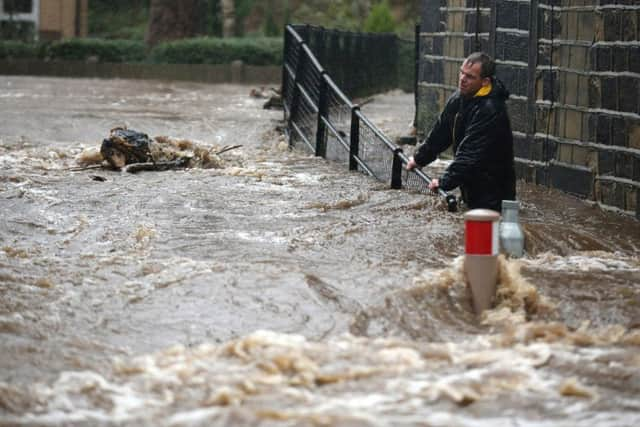How Calderdale’s reservoirs can be secret new weapon in flooding fight if law is changed – Holly Lynch


My constituency, particularly Sowerby Bridge and Copley, was badly impacted by the floods. However, it was the total devastation further down the valley in Mytholmroyd and Hebden Bridge, with further damage in Elland, Todmorden and Brighouse, that brought Secretaries of State and the national Press to Calderdale to see the unprecedented damage.
Advertisement
Hide AdAdvertisement
Hide AdThe River Calder was described as having become “weaponised” over Boxing Day, picking up everything in its path and using it to smash its way through the valley, taking out bridges, roads, homes and businesses.


In total, 2,781 residential properties and 1,635 businesses were affected in Calderdale alone. Residents are genuinely fearful every time the forecasts suggest that heavy rainfall is on its way.
Advertisement
Hide AdAdvertisement
Hide AdMany different initiatives have begun to help ensure that that level of destruction cannot be inflicted again. My Reservoirs (Flood Risk) Bill proposes to add to that package of initiatives.


The hard infrastructure work is currently ongoing across the borough, including the centre of Mytholmroyd with a new bridge and widened channel. Similar works are scheduled to start shortly in Hebden Bridge, providing the funding gap can be closed. Natural flood management has also been a significant part of our response. Since 2016, they have been working with the National Trust, the Environment Agency and Calderdale Council, using the natural environment to build leaky dams across streams, and to stuff deep gullies and channels.
This work seeks to spread the water as it makes its way down the valley, to prevent it from coursing rapidly through channels to the valley below – delaying its journey to hold as much water up in the crags as possible. Managing the upper catchment in this way is essential if we are to do all that we can to mitigate flood risk for those in the valleys below.
Advertisement
Hide AdAdvertisement
Hide AdAlso in the upper catchment above Calder valley are six Yorkshire Water reservoirs, and conversations about their role in mitigating flood risk have been under way for some time. The Bill seeks to formalise that process and demonstrate Parliamentary support for its aims.


In the winter of 2017-18, Yorkshire Water and the Environment Agency started a trial to manage the Hebden Water reservoirs down to 90 per cent of their usual top storage level, with the aim of assessing the potential of utilising the reservoirs as a more long-term flood risk management option.
Maintaining the reservoirs at 90 per cent, instead of the usual 100 per cent, created the extra 10 per cent capacity to hold more water in the upper catchment during periods of unusually heavy rainfall.
While the reservoirs were placed under nothing like the pressure of the 2015 Boxing Day weather during the trial period, the report was able to conclude that “the lower reservoir levels did provide a significant impact on peak flows in Hebden Water for the largest events observed during this period”.
Advertisement
Hide AdAdvertisement
Hide AdThe report proposed that next steps might include trialling 85 per cent capacity, as the levels in the reservoir had been restored faster than expected during periods of rainfall.


This approach is not just happening in Calderdale. Similar conversations and trials are under way across the country, including at Thirlmere reservoir in Cumbria, reservoirs in the Upper Don valley and Watergrove reservoir in Rochdale.
So why do we need legislation to make this happen? There are still challenges that need to be ironed out before water companies have the confidence to commit to these types of scheme more routinely. Currently, the legislation that underpins water companies and the regulation of them has a focus on mitigating drought risk, rather than flood risk.
We know that extreme weather will increase in frequency in the years to come, and reservoirs will be key in ensuring resilience within our water infrastructure if we are to manage both drought and flood risk. Right now, we need to give reservoir management of this kind a statutory thumbs-up, explicitly giving the Environment Agency the powers to instruct a water company to manage down the levels on pre-designated reservoirs, where the evidence suggests that doing so would reduce flood risk and protect communities.
Advertisement
Hide AdAdvertisement
Hide AdTo be clear, it would not be a case of drawing those reservoir levels down at speed at the point when we are faced with extreme weather, as that would place dangerous pressures on the watercourses and, if anything, contribute to flood risk. Instead, the Bill would set out a framework for having agreements in place long in advance of that for the EA and water companies to have identified which reservoirs, what capacity level is appropriate and when that reduction would be in place.
Holly Lynch is the Labour MP for Halifax. She intrdouced the Reservoirs (Flood Risk) Bill to Parliament – this is an edited version.